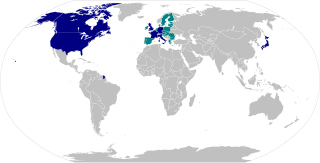
The G8, reformatted as G7 from 2014 due to the suspension of Russia's participation, was an inter-governmental political forum from 1997 until 2014.

The Group of Seven (G7) is a group consisting of Canada, France, Germany, Italy, Japan, the United Kingdom, and the United States. These countries, with the seven largest IMF-described advanced economies in the world, represent 58% of the global net wealth ($317 trillion). The G7 countries also represent more than 46% of the global gross domestic product (GDP) based on nominal values, and more than 32% of the global GDP based on purchasing power parity. The European Union is also represented at the G7 summit.

The G20 is an international forum for the governments and central bank governors from 19 countries and the European Union. Founded in 1999 with the aim to discuss policy pertaining to the promotion of international financial stability, the G20 has expanded its agenda since 2008 and heads of government or heads of state, as well as finance ministers and foreign ministers, have periodically conferred at summits ever since. It seeks to address issues that go beyond the responsibilities of any one organization.

Global warming is a long-term rise in the average temperature of the Earth's climate system, an aspect of climate change shown by temperature measurements and by multiple effects of the warming. Though earlier geological periods also experienced episodes of warming, the term commonly refers to the observed and continuing increase in average air and ocean temperatures since 1900 caused mainly by emissions of greenhouse gasses in the modern industrial economy. In the modern context the terms global warming and climate change are commonly used interchangeably, but climate change includes both global warming and its effects, such as changes to precipitation and impacts that differ by region. Many of the observed warming changes since the 1950s are unprecedented in the instrumental temperature record, and in historical and paleoclimate proxy records of climate change over thousands to millions of years.
Mediavia aciusa is a species of snout moth in the genus Mediavia. It was described by Schaus in 1925. It is found in South America.
Mediavia agnesa is a species of snout moth in the genus Mediavia. It was described by Schaus in 1922. It is found in Guatemala.
Mediavia discalis is a species of snout moth in the genus Mediavia. It was described by George Hampson in 1906. It is found in French Guiana.
Mediavia dissimilis is a species of snout moth in the genus Mediavia. It was described by Warren in 1891. It is found in Brazil.
Mediavia eadberti is a species of snout moth in the genus Mediavia. It was described by Schaus in 1925. It is found in South America.
Mediavia emerantia is a species of snout moth in the genus Mediavia. It was described by Schaus in 1922. It is found in Peru.
Mediavia glaucinalis is a species of snout moth in the genus Mediavia. It was described by George Hampson in 1906. It is found in Suriname.
Mediavia grenvilalis is a species of snout moth in the genus Mediavia. It was described by Schaus in 1934. It is found in Brazil.
Mediavia hermengilda is a species of snout moth in the genus Mediavia. It was described by Schaus in 1925. It is found in South America.
Mediavia ildefonsa is a species of snout moth in the genus Mediavia. It was described by Schaus in 1922. It is found in Guatemala.
Mediavia internigralis is a species of snout moth in the genus Mediavia. It was described by Paul Dognin in 1909. It is found in French Guiana.
Mediavia longistriga is a species of snout moth in the genus Mediavia. It was described by Schaus in 1922. It is found from Guatemala to South America.
Mediavia phaebadia is a species of snout moth in the genus Mediavia. It was described by Schaus in 1925. It is found in South America.
Mediavia vimina is a species of snout moth in the genus Mediavia. It was described by Schaus in 1922. It is found in Guatemala.




